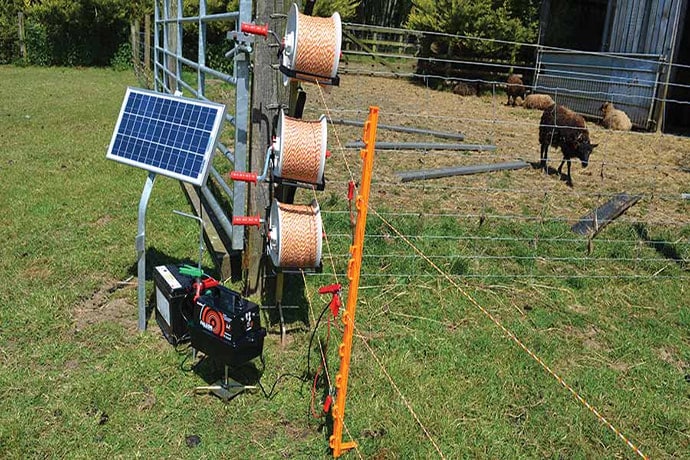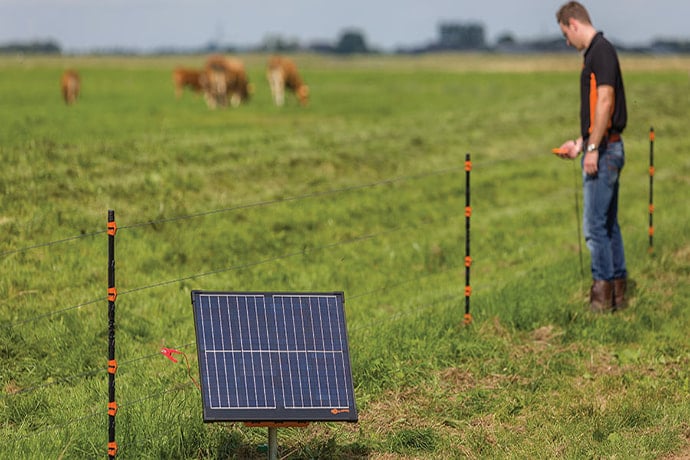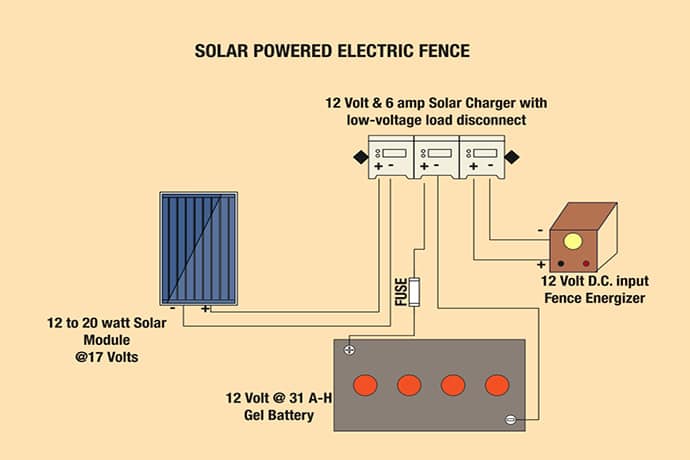Table of Contents
Solar power has extended many applications over the past few years. One current use of solar energy is for charging electric fences. Homeowners who want to reduce overall power consumption or homeowners who do not have a power connection near the fence can choose a solar-powered fence. Solar-powered fences are an environmentally friendly and reasonably priced charging treatment plan. Because they do not consume electricity or use fuel.
In general, the power consumption of a power fence is about 5-40 watts, depending on its size and model. You can choose Sungold solar panels with different capacities and sizes to power any size of power fence.
In this guide, we will discuss what a solar electric fence is, how it works, and whether a solar generator can power it.
What is A Solar Electric Fence?
Solar electric fence is an environmentally friendly alternative to traditional electric fencing. With a solar-powered electric fence, you can reduce your electric bill while protecting your livestock and crops from damage.
Solar panels convert sunlight into solar energy and are connected to a solar charger to further power the fence energy supply installation. In addition, many solar fences have a battery that is capable of storing electricity during the day and charging the fence at night or when there is no sunlight.
Are Solar Electric Fences Any Good?
If you have a solar fence charger equipped with an auxiliary battery, the electric fence remains functional even at night. However, in the absence of a solar fence charger with a battery, you’ll need to establish an alternative power source, such as a plug-in electric fence charger or a generator, to ensure continuous operation.
Advantages And Disadvantages Of Solar Electric Fences
Solar electric fences are an environmentally friendly solution for securing your home garden or livestock. They are highly cost-effective, especially for rural areas. Since they are powered by solar energy, you don’t have to worry about grid interruptions or power connection problems near the fence.
- Green and clean energy works with solar energy and emits no fumes.
- National Preferential Policies
- Provides free and unlimited power, ensuring you can reduce your electricity usage.
- Easy to install.
- Initial Cost: The upfront cost of purchasing and installing a solar electric fence can be higher than traditional electric fences. This includes the cost of solar panels, batteries, and the fence itself.
- Maintenance: Solar electric fences require regular maintenance. Solar panels need to be kept clean and free from obstructions to ensure they receive optimal sunlight. Battery maintenance and replacement may also be necessary over time.
- Limited Power: Solar electric fences are dependent on sunlight to charge the batteries. During cloudy days or in regions with limited sunlight, the fence’s power output may decrease, potentially compromising its effectiveness.
- Battery Life: The batteries used in solar electric fences have a limited lifespan. Over time, they may need replacement, which can add to the overall cost of ownership.
- Complex Installation: Installing a solar electric fence can be more complex than a traditional electric fence. It requires positioning the solar panels correctly and ensuring the fence is properly grounded.
Despite some disadvantages, but many people find that the benefits of solar electric fences, such as their sustainability and cost savings over time, outweigh these drawbacks, especially in remote areas where access to grid electricity is limited.

Do Solar Electric Fences Work at Night?
Solar electric fences primarily rely on sunlight for energy, making them inactive at night. During the day, solar panels on the charger collect and convert sunlight into electricity to power the fence. Some solar fence chargers have batteries to store excess daytime energy, enabling nighttime operation. If your solar charger has a battery, it continues working after sunset. Without a battery, you’ll need alternative power sources like plug-in chargers or generators for nighttime fence functionality, especially for security or animal containment.
How Much Solar Energy Does an Electric Fence Need?
The solar energy usage of an electric fence depends on the model you are using. It typically consumes 5 to 40 watts of electricity, with larger fences consuming more than 100 watts. You can check the wattage of your electric fence to estimate the amount of solar energy needed.
For example, if your solar electric fence is going to use 100 watts solar panel, then a 100-watt solar panel will be enough to run it. However, you won’t be able to charge your electric fence at night because the solar panels depend on sunlight to work.
In summary, the solar power requirements for an electric fence depend on several factors, including the energy consumption of your electric fence charger and the amount of sunlight available in your location. Here is a general guide to help you determine the necessary solar panel capacity for your electric fence:
1. Calculate the energy consumption of your electric fence charger:
– Check the specifications or manual of your electric fence charger to find its daily power consumption, typically measured in joules per day or watt-hours per day. This data is crucial for calculating the required solar panel capacity.
2. Determine the average daily sunlight hours in your region:
– Identify the average daily sunlight hours in your area, which can be obtained from solar insolation maps or local weather data. This information will aid in estimating how much energy the solar panels can generate each day.
3. Calculate the required solar panel capacity:
– Divide the daily energy consumption of your electric fence charger (in watt-hours per day) by the average daily sunlight hours in your region. This calculation will provide you with the minimum solar panel capacity needed.
Now, let’s consider two different solar panel options:
– If your calculations indicate that you need more than 65 watts solar panel capacity to meet the daily energy requirements of your electric fence charger, then 65-watt solar panels should be sufficient, provided their capacity meets or exceeds the calculated requirement. You can use one or multiple solar panels to achieve the necessary capacity.
– Similarly, if your calculations show that 50 watts of solar panel capacity are enough to meet the daily energy needs of your electric fence charger, you can opt for 50-watt solar panels. However, bear in mind that solar panels often come in standard sizes, so you may need to choose the nearest available size that matches or exceeds your calculated requirement.
It’s essential to note that these calculations are approximate, and the exact solar panel requirements may vary based on the factors mentioned. It’s advisable to consult with professionals or local solar installers to ensure that your system adequately meets the energy needs of your electric fence under varying weather conditions. Additionally, consider factors such as panel efficiency, panel orientation, shading, and installation angles that may impact performance.
The Pitfalls of Solar Panels
There are many cheap solar panels available online. Acquiring a panel that is too small will not extend battery life, and choosing a panel that is too large may damage the battery and booster unless the output is conditioned.
The wattage of the panel should supplement the wattage of the energizer. You can use a charge controller. It is easy to connect between the panel and the battery and ensures that the voltage stays safe.



























